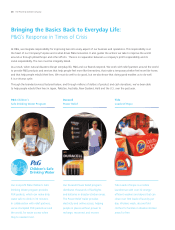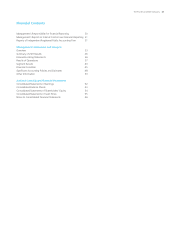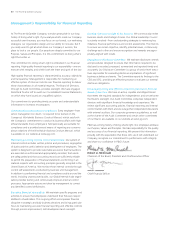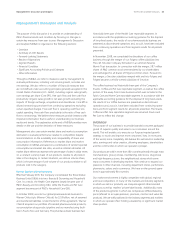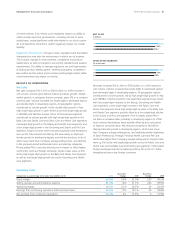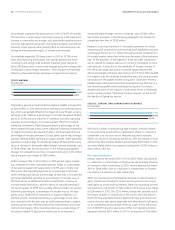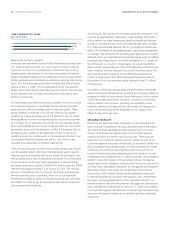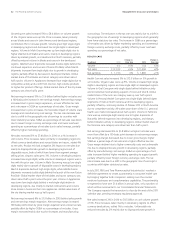Proctor and Gamble 2011 Annual Report Download - page 38
Download and view the complete annual report
Please find page 38 of the 2011 Proctor and Gamble annual report below. You can navigate through the pages in the report by either clicking on the pages listed below, or by using the keyword search tool below to find specific information within the annual report.36 The Procter & Gamble CompanyManagement’s Discussion and Analysis
SUMMARYOF 2011 RESULTS
ō Net sales increased % to $.billion.
–Organic sales increased %.
–Unit volume increased % versus the prior year, behind double-
digit growth in developing regions and low single-digit growth in
developed regions.
ō Net earnings from continuing operations increased % to $.8bil-
lion behind sales growth and a lower effective tax rate, partially
offset by operating margin contraction.
–Operating margin declined 110 basis points behind a reduction in
gross margin, partially offset by a reduction in selling, general
and administrative expenses (SG&A) as a percentage of net sales.
Gross margin declined behind higher commodity costs, partially
offset by manufacturing cost savings. SG&A as a percentage of
net sales declined due to reduced foreign currency exchange
costs and a reduction in overhead spending as a percentage of
net sales due to productivity improvements, partially offset by
increased marketing investments.
ō Net earnings decreased 7% to $11.8billion.
–Net earnings from discontinued operations declined $1.8billion
due to the gains on the sale of the pharmaceutical business in
the prior year.
ō Diluted net earnings per share from continuing operations
increased 11% to $3.93.
–Diluted net earnings per share declined 4% to $3.93, including a
decline in discontinued operations of $0.58.
–Core EPS grew 8% to $3.95.
ō Cash flow from operating activities was $13.2billion.
–Free cash flow was $9.9billion.
–Free cash flow productivity was 84%.
FORWARD-LOOKING STATEMENTS
We discuss expectations regarding future performance, events and
outcomes, such as our business outlook and objectives, in annual and
quarterly reports, press releases and other written and oral communi-
cations. All such statements, except for historical and present factual
information, are “forward-looking statements,” and are based on
financial data and our business plans available only as of the time the
statements are made, which may become out-of-date or incomplete.
We assume no obligation to update any forward-looking statements as
a result of new information, future events or other factors. Forward-
looking statements are inherently uncertain and investors must recognize
that events could be significantly different from our expectations.
Formore information on risks that could impact our results, refer to
Item1A Risk Factors in our most recent 10-Q,10-K and 8-K filings.
Ability to Achieve Business Plans.We are a consumer products
company and rely on continued demand for our brands and products.
To achieve business goals, we must develop and sell products that
appeal to consumers and retail trade customers. Our continued success
is dependent on leading-edge innovation with respect to both products
and operations, on the continued positive reputations of our brands
and our ability to successfully maintain trademark protection. This
means we must be able to obtain patents and trademarks, and respond
to technological advances and patents granted to competition. Our
success is also dependent on effective sales, advertising and market-
ing programs. Ourability to innovate and execute in these areas will
determine the extent to which we are able to grow existing sales and
volume profitably, especially with respect to the product categories
and geographic markets (including developing markets) in which we
have chosen to focus. There are high levels of competitive activity in
the environments in which we operate. To address these challenges, we
must respond to competitive factors, including pricing, promotional
incentives, trade terms and product initiatives. We must manage each
of these factors, as well as maintain mutually beneficial relationships with
our key customers, in order to effectively compete and achieve our
business plans. As a company that manages a portfolio of consumer
brands, our ongoing business model involves a certain level of ongoing
acquisition and divestiture activities. We must be able to successfully
manage the impacts of these activities, while at the same time deliv-
ering against base business objectives. Daily conduct of our business
also depends on our ability to maintain key information technology
systems, including systems operated by third-party suppliers.
Cost Pressures.Our costs are subject to fluctuations, particularly due
to changes in commodity prices, raw materials, labor costs, foreign
exchange and interest rates. Therefore, our success is dependent, in
part, on our continued ability to manage these fluctuations through
pricing actions, cost savings projects, sourcing decisions and certain
hedging transactions. We also must manage our debt and currency
exposure, especially in certain countries with currency exchange controls,
such as Venezuela, China and India. We need to maintain key manu-
facturing and supply arrangements, including sole supplier and sole
manufacturing plant arrangements, and successfully manage any
disruptions at Company manufacturing sites. We must implement,
achieve and sustain cost improvement plans, including our outsourcing
projects and those related to general overhead and workforce optimi-
zation. Successfully managing these changes, including identifying,
developing and retaining key employees, is critical to our success.
Global Economic Conditions. Economic changes, terrorist activity,
political unrest and natural disasters, such as the civil unrest in the
Middle East and the impacts of the Japan earthquake and tsunami,
may result in business interruption, inflation, deflation or decreased
demand for our products. Our success will depend, in part, on our
ability to manage continued global political and/or economic uncer-
tainty, especially in our significant geographic markets, due to terrorist
and other hostile activities or natural disasters. We could also be
negatively impacted by a global, regional or national economic crisis,
including sovereign risk in the event of deterioration in the credit
worthiness of a default by local governments, resulting in a disruption




